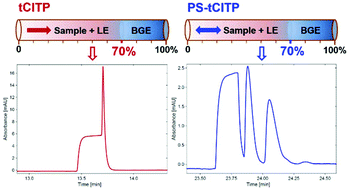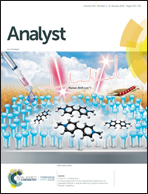A separation voltage polarity switching method for higher sample loading capacity and better separation resolution in transient capillary isotachophoresis separation†
Abstract
A separation voltage polarity switching transient capillary isotachophoresis (PS-tCITP) was developed to overcome a major sample loading volume limitation in transient capillary isotachophoresis (tCITP). The fundamental idea of PS-tCITP is to let sample ions move back and forth in a separation capillary during their initial isotachophoresis focusing stage by switching the polarity of the separation voltage, in order to both increase the sample loading volume and improve the separation efficiency as compared to the conventional tCITP method. The experimental evaluation of the novel PS-tCITP method by using two peptide standards at 2 μM concentration showed that the maximum sample loading volume could be increased from 45% of the total separation capillary volume in tCITP to 70% in PS-tCITP, which resulted in a more than 1.5 fold increase in the peptide peak intensity at a given length/volume of the separation capillary. Due to the consecutive focusing of sample volume from each polarity switching of the separation voltage, the separation time window at a given sample loading volume was also increased significantly in PS-tCITP as compared to tCITP. Experiment comparison between tCITP and PS-tCITP at 45% sample loading volume using the same setup showed that the migration time difference between the two peptide peaks increased from 0.3 min in tCITP to 0.363 min in PS-tCITP with similar peak widths and heights, resulting in roughly a 21% improvement in separation resolution. The performance advantages of PS-tCITP separation over tCITP separation were further verified by using a mixture of six peptide standards.



 Please wait while we load your content...
Please wait while we load your content...